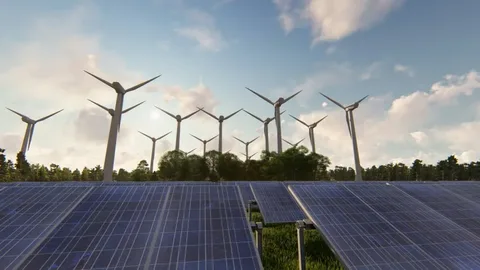Introduction
The Asia Pacific Renewable Energy Market is experiencing rapid growth as countries in the region focus on sustainable energy sources, including solar, wind, hydro, and biomass. Government initiatives, environmental concerns, declining costs of renewable technologies, and increasing electricity demand are driving adoption. The market encompasses utility-scale projects, distributed energy systems, and emerging technologies like offshore wind and hybrid renewable systems.
Market Drivers
1. Government Policies and Incentives
Renewable energy targets, subsidies, and favorable regulations encourage deployment.
2. Declining Costs of Technology
Falling prices of solar panels, wind turbines, and energy storage systems make renewable energy more affordable.
3. Rising Electricity Demand
Industrialization, urbanization, and population growth increase demand for clean energy.
4. Environmental Concerns
Reduction of carbon emissions and reliance on fossil fuels drives renewable energy adoption.
5. Technological Advancements
Energy storage, smart grids, and hybrid systems improve efficiency and grid integration.
Market Challenges
1. Intermittency of Renewable Sources
Solar and wind energy depend on weather conditions, creating reliability concerns.
2. Grid Integration Issues
Limited infrastructure and outdated transmission networks can hinder deployment.
3. High Initial Capital Expenditure
Large-scale projects require significant upfront investment, affecting smaller developers.
4. Land and Resource Constraints
Availability of suitable land and water resources for renewable projects can be limited.
5. Policy and Regulatory Changes
Inconsistent regulations across countries may impact project feasibility.
Opportunities
1. Energy Storage Integration
Battery systems and hybrid renewable solutions enhance reliability and grid stability.
2. Offshore Wind and Marine Energy
Emerging technologies like offshore wind provide significant growth potential.
3. Distributed Energy Systems
Rooftop solar, mini-grids, and community-based energy solutions expand market reach.
4. Industrial and Commercial Adoption
Corporates and industrial facilities increasingly invest in renewable energy solutions.
5. Emerging Economies
India, Southeast Asia, and Africa are investing in renewable energy infrastructure, offering growth opportunities.
Regional Insights
China
China leads in renewable energy installations, focusing on solar, wind, and hydropower projects.
India
Rapid solar adoption, government initiatives, and renewable energy auctions drive market growth.
Southeast Asia
Countries like Vietnam, Thailand, and Indonesia focus on solar, wind, and biomass energy projects.
Australia & New Zealand
Investment in solar, wind, and hydro projects increases renewable energy capacity.
Japan & South Korea
Technology-driven adoption of solar and wind energy, along with energy storage systems.
Future Outlook
The Asia Pacific Renewable Energy Market is expected to grow steadily over the next decade. Falling technology costs, energy storage integration, government incentives, and rising electricity demand will drive adoption. Emerging technologies like offshore wind, hybrid systems, and distributed energy resources will further expand market potential.
Conclusion
Renewable energy adoption in the Asia Pacific region is driven by environmental concerns, government initiatives, and declining technology costs. Solar, wind, hydro, and emerging hybrid systems will continue to play a critical role in meeting the region’s growing electricity demand. Companies investing in innovative, efficient, and scalable solutions are positioned for long-term success.

